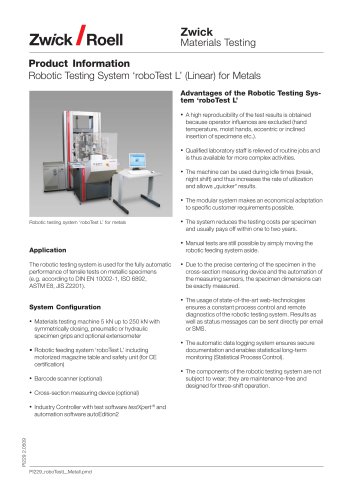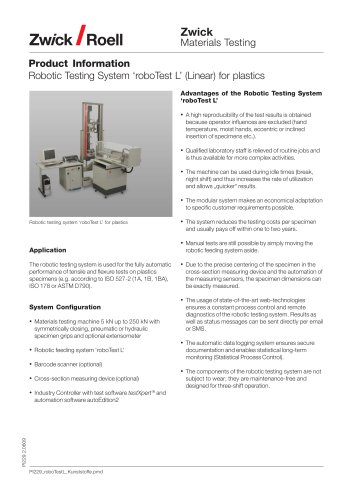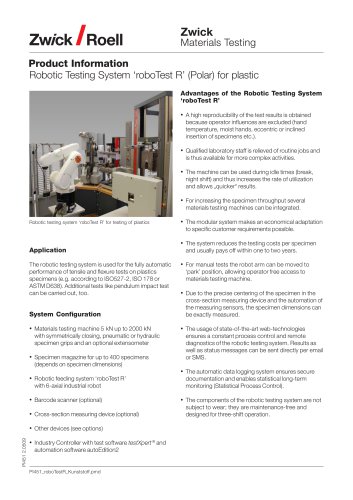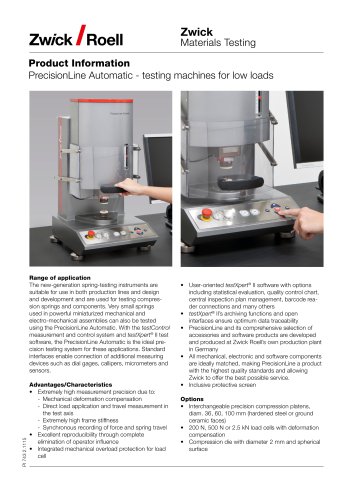
Catalog excerpts

Testing systems Testing of Plastics and Rubber Intelligent Testing
Open the catalog to page 1
1 Zwick Roell Group Content 1.1 With passion and expertise 1.2 Your dependable partner for polymer testing 2 Plastics testing Content 2.1 Application overview 2.2 Molding materials and plastic products 2.3 Testing pipes 2.4 Testing films and sheet materials 2.5 Testing welded and glued joints 2.6 Soft foams 2.7 Hard foams 2.8 Component testing 3 Rubber testing Content 3.1 Application overview 3.2 Materials testing on rubber and elastomers 3.3 Testing dampers and bearings 3.4 Testing tires / 3.5 Testing seals 4 Products and services for plastics and rubber testing Content 4.1 Dimensional...
Open the catalog to page 2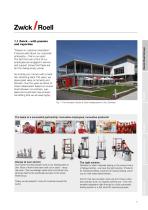
Zwick Roell Group 1.1 Zwick – with passion and expertise “Passion in customer orientation.“ If anyone asks about our corporate philosophy – that is our reply! The fact that over a third of our employees are engaged in service and support shows that these are far from being empty words. As a family-run concern with a tradition stretching back 150 years, we place great value on honesty and fairness. Over the years an ethos of close collaboration based on mutual trust between our partners, suppliers and customers has evolved, something that we all value highly. Fig. 1: The Innovation Center at...
Open the catalog to page 3
1.2 Zwick - your dependable partner for polymer testing System-based testing solutions For over 60 years Zwick has been developing testing machines and instruments for tests on plastics and rubber. Generations of researchers, developers and quality assurance specialists have achieved success using Zwick testing equipment, relying on the accurate test results, the highly advanced measuring methods and the high availability guaranteed with Zwick products. Our comprehensive range of testing equipment is a product of our experience and commitment backed by close collaboration with our...
Open the catalog to page 4
One of Zwick’s particular strengths lies in the characterization of molding materials as specified in standards such as ISO 10350 (single-point data), ISO 11403 (multi-point data) and ISO 17282 (design data). Many of these results are obtained using Zwick testing equipment and are made available by members of the CAMPUS team via their website at: www.campusplastics.com. Another key area is the wide realm of product and component testing. Here specimens are taken from finished products. Sections of the product are tested or the entire finished product is subjected to mechanical loading to...
Open the catalog to page 5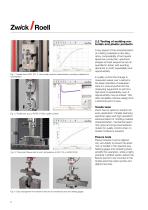
2.2 Testing of molding materials and plastic products A key aspect of the characterization of molding materials is inter-laboratory comparability of test results. Specimen production, specimen shapes and test sequences are all specified in detail, with exacting demands on both repeatability and reproducibility. Fig. 1: Tensile test to ISO 527-2 with tensile modulus determination (moulding material characterization) Fig. 2: Tensile test, e.g. to ASTM D 638. (quality control) Fig. 3: Three-point flexure test at room temperature to ISO 178 or ASTM D790 Fig. 4: Easy changeover from tensile to...
Open the catalog to page 6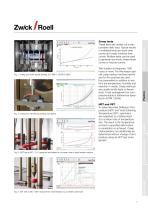
Zwick Roell Group Rubber Fig. 2: Creep test with flexural loading, ISO 899-2 HDT and VST To determine Heat Deflection Temperature (HDT) and Vicat Softening Temperature (VST), specimens are subjected to a defined load at a constant rate of temperature rise. The result is the temperature at which a specified deformation or penetration is achieved. Creep characteristics can additionally be determined without change of temperature using an HDT test arrangement. Products & Services Fig. 1: Creep test under tensile loading, ISO 899-1, ASTM D 2990 Test duration is frequently 1000 hours or more....
Open the catalog to page 7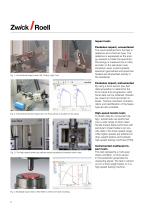
Impact tests Fig. 1: Conventional impact tests: left, Charpy; right, Izod Pendulum impact, conventional The result obtained from this test is resilience and a fracture type. The resilience is expressed as the energy required to break the specimen; this energy is measured via a rotary encoder on the pendulum axis. Pendulum sizes, impact speeds, specimen geometries and specimen holders are all specified exactly in the standards. Pendulum impact, instrumented By using a force sensor plus fast data acquisition to determine the force-travel-time progression, additional data can be obtained....
Open the catalog to page 8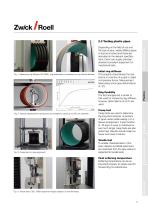
Depending on the field of use and the type of pipe, widely differing types of test are involved and these are described in the relevant specifications. Zwick can supply precision, standard-compliant equipment for mechanical tests. Initial ring stiffness This property characterizes the resistance of a section of a pipe to radial compressive forces. Measurement takes place at low pipe deformations of 3%. Ring flexibility The test arrangement is similar to that used for measuring ring stiffness; however, deformations of 30 % are used. Fig. 3: Creep tests on pipe segments Creep test Creep tests...
Open the catalog to page 9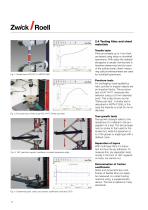
2.4 Testing films and sheet materials Fig. 1: Tensile test to ISO 527-3, ASTM D 882 Tensile tests Films and sheets up to 1mm thick are tested using strips or dumbbell specimens. With strips the material elongation is usually nominal and is therefore determined via the travel of the pulling clamp; direct-measuring optical extensometers are used for dumbbell specimens. Puncture tests For packaging, loads applied by hard, pointed or angular objects are an important factor. The puncture test to EN 14477 measures this behavior using a 0.8 mm-diameter point. This is also known as the ‘Parker pen...
Open the catalog to page 10
Peel resistance tests Peel resistance is measured in the pull-off adhesion test. As this depends significantly on the peel angle, standardization has produced a whole range of test methods. Zwick has test fixtures to suit each of these. Fig. 1: 90° peeltest to measure peel resistance • 90° peel test • 180° peel test • Floating roller peel test • Sealed seam test Fig. 2: Testing the sealed seam on a yoghurt pot. The peel angle remains constant. Initial adhesion This property is determined for items such as adhesive labels and adhesive tapes. The initial adhesion is expressed as the maximum...
Open the catalog to page 11All ZWICK GMBH & CO. KG catalogs and technical brochures
-
HC Series
2 Pages
-
HB series
3 Pages
-
Vibrophore 1000
3 Pages
-
Vibrophore 250
3 Pages
-
Vibrophore 100
3 Pages
-
Vibrophore 50
3 Pages
-
Vibrophore 25
3 Pages
-
LTM
5 Pages
-
roboTest A
2 Pages
-
roboTest B
2 Pages
-
roboTest I
2 Pages
-
roboTest L FOR METALS
2 Pages
-
roboTest L FOR PLASTICS
2 Pages
-
roboTest L FOR ELASTOMERS
2 Pages
-
roboTest P
2 Pages
-
H-series
2 Pages
-
Z330E
3 Pages
-
Materials testing
2 Pages
-
HDT/Vicat Standard
4 Pages
-
Vicat Dry
2 Pages
















